We hear about relative humidity in the weather forecast every day. What is relative humidity level and why is it important to us?
Humidity has a serious impact on our health and overall emotional state. Knowing its level, we can improve indoor air quality by reducing the impact of many undesirable factors. Too high humidity can lead to an increase in biological contaminants such as mold, bacteria, viruses, fungi and dust mites, which can cause allergies and various respiratory diseases. It can also cause arthritis, increased fatigue and migraines. If the humidity is too high, your home will have a constant musty smell. Too low humidity is also extremely hazardous to human health. It can lead to nosebleeds, eye irritation, itching, difficulty breathing, static electricity damage, and emotional irritability.
If he is dehydrated, the kidneys will retain water and the urine will be dark, strong. If the body is hydrated normally, the urine will have an open yellowish color. Thus, you need to consume enough fluids to replace those lost during perspiration.
Measures to prevent exposure to heat
A few general measures by which we can prevent unwanted effects from exposure to high temperatures. Thirst is the first symptom to show that the body is dehydrated. ... Avoid strenuous physical activity during peak hours. It is advisable that people working on the street do their work in the morning, before the onset of excessive heat, if necessary, take frequent breaks and shelter in the shade.
The physical and psychological effects of humidity on the human body have been the subject of many clinical studies conducted by many national institutions in the USA, Canada and Russia over the past few years.
Since 400 BC. people divided all types of diseases depending on weather conditions. When the temperature rises, it becomes more difficult for our bodies to function. Our heart works harder, our blood vessels narrow and blood pressure rises. If there is poor air quality in the room, we will have a decrease in the protective function of the lungs, as a result of which cardiovascular and respiratory diseases will appear. Dry air causes asthma, bronchitis, sinusitis, pharyngitis, pharyngotracheitis, tracheobronchitis and a number of other diseases. This is confirmed by a research article published on the website PubMed Central - the US National Center for Biotechnology Information. Studies have shown that the concentration of bacteria and viruses in the air is minimal at a relative humidity of 40 to 60%. As can be seen from the graph, the causative agents of asthma - dust mites and fungi cannot live at a humidity level of less than 50%. If you eliminate the cause, you will reduce the likelihood of respiratory diseases to zero.
Sudden changes in temperature cause health problems. The body adjusts to these temperature changes after 14 days. What's more, the transition from warmth to rain and cloudy weather is especially affecting children, the elderly and chronic patients. Optimal weather is good for the body.
The optimal time is considered to be the weather, which has a beneficial effect, creating a good mood, preserving the body due to any problems. The exciting and harsh weather creates discomfort. Exciting weather includes a period when one or more meteorological elements deviate from optimal values. This weather, although sunny, often shows a gloomy sky and humidity rises to nearly 90% RH.
This is also evidenced by research conducted at the University of Oregon. They point to a key role in reducing the concentration of influenza-causing germs and maintaining proper humidity levels. Humidification of the room is extremely important in the cold winter months, when your heating system dries up the air and you cannot maintain an optimal humidity level without special devices - climatic systems or humidifiers. It will make you feel more comfortable and protect your body from the flu and its damaging health consequences.
Temperature fluctuations increase the risk of certain conditions. Temperature fluctuations negatively affect the human body, say experts from the US National Institutes of Health. According to them, a sudden decrease or increase in temperature affects metabolism, and the risk of asthma, lung and respiratory diseases, allergies, depression and nutritional problems is quite high. These studies have shown that the human body has begun to lose its ability to adapt to temperature fluctuations, and when the body is weak, the health consequences can be quite serious.
Another interesting article devoted to the problem of the influence of relative humidity on human health was published in USA Today - the national publication of the United States. It says that if the humidity level in the room is constantly outside 30% and 60%, a person has respiratory diseases, skin irritation, sore throat, and pests, fungi, rot, dust mites appear in his house, mold leading to allergic reactions. Any of the microorganisms listed above can compromise your health, leaving you in a hospital bed.
High temperatures have been associated with an increase in the number of patients suffering from stress or nutritional problems, and low temperatures are responsible for the onset of respiratory diseases such as asthma or pulmonary disease. Heart problems caused by temperature changes.
These fluctuations can also lead to an exacerbation of cardiovascular disease. Thus, a person suffering from high blood pressure, a condition that can be controlled, is at risk of a heart attack. One explanation is that these climate changes are interacting with medications prescribed for hypertensive patients. Among the people most susceptible to sudden changes in temperature are smoking.
That is why today the well-known weather channel The Weather Channel in the USA, the meteorological services in England and Germany daily provide information for weather-sensitive people so that they have time to prepare for changes in weather and possible reactions to an increase / decrease in the level of relative humidity in the air. We receive similar information from weather forecasts on domestic television. Although five years ago, the announcer gave us dry numbers without any explanation. At present, special attention is paid to these data.
Time changes, rheumatic pain occurs. Because of the cold and humid air, people with rheumatism experience great pain. Moreover, humid air fronts exacerbate various forms of chronic degenerative rheumatism. Low immunity leads to viral infections.
The explanation is that they are trying to cope with this passage when faced with moisture and cold. The immune system is weakened and the body becomes vulnerable to viral infections. At the same time, the presence of nasal polyps, allergies that affect the nasal mucosa and prolonged stress increase the risk of viral infections. Dizziness, headache and extreme tiredness.
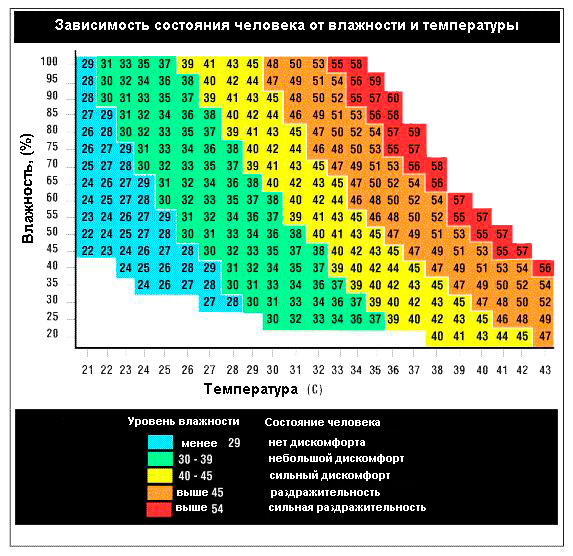
So, the ideal indoor humidity level should be between 40% and 60%. Fortunately, our body is able to adapt to climatic conditions and we do not need to maintain humidity at an extremely accurate level. It is important to avoid extremes when creating a microclimate in artificial conditions. If the humidity is too low or too high, you will not feel negative effects in a short period of time, but in the long term the consequences can be quite unpleasant. That is why Sharp has developed a climate complex capable of using highly sensitive sensors to determine the state of the atmosphere in the room and humidify the air within specified limits depending on the temperature and purify it. Climate complex Sharp completely repeats the natural process of air ionization, due to which its purification and humidification of the air is as gentle as possible for humans. This is the main difference between Sharp and conventional humidifiers, most of which are not capable of analyzing indoor humidity and temperature. Naturally, an ordinary budget humidifier can oversaturate the air with moisture. Excessive humidity also leads to adverse effects. To avoid this, you will have to monitor its operation yourself and periodically turn it off. Agree, in our time of fast-paced life, this is extremely inconvenient, since we cannot always remember this in time.
When the weather suddenly cools down, many people experience dizziness and headaches. For this reason, it is useful to help the immune system by consuming, on the one hand, a lot of vegetables and fruits, because they contain vitamins and minerals, and on the other hand, nutritional supplements. In this way, we can prevent damage caused by these temperature fluctuations.
Physician of primary family medicine. The etymology comes from two Latin words: "legumes", which means growing crops for human food; “Culture”, which refers to the ability to work the land and care for plants. The terminology used in the major languages \u200b\u200bhas the same content. On the english language defined as "vegetable crops" or "vegetable crops". It is a generic name attributed to parts of a plant, or even whole plants, used in the healing process. The term "vegetable" is often used, which is an expression of Turkish origin, which is equivalent to the term "vegetation". vegetables and therefore it is inappropriate to say "vegetables and barley" because both terms define the same thing. The expression "soup soup" refers to carrots, parsley, parsley for the leaves, possibly celery for the root. Vegetable culture was one of the first practical exercises. With the development of society, knowledge and methods of decultivation of plant plants Thus, the plant plant has strengthened as an independent science, separating itself from phytotechnics, of which it is broader. The improvement of field farming technologies in the field, the emergence and development of greenhouses and greenhouses, as well as those that are protected in shelters made of plastic or glass without a constant source of heating, have led to an even greater differentiation of adduction as an independent science. the goals of this plant plant can be fully defined as follows: Vegetable culture is a science that deals with the study of biological characteristics different types vegetables, their biological and ecosystem relationships, purification of conditions that meet the requirements of the species and varieties of plants. to make the best use of their biological potential and achieve high quality, high quality products, reeling throughout the course and cost-effective conditions. Knowledge of the botanical characteristics of plant species is especially important as it establishes culture. For example, latomata: when grown by seedlings, the root system penetrates into the shallow depth of the soil and must intervene with more irrigation to supply the plants. In tomato crops, by direct sowing, the root system penetrates deep into the soil of the monkeys, and the plants can supply water from deeper soil layers, requiring less irrigation and higher rates. Tomatoes with indeterminate growth must be maintained in a variety of ways, while those with undetermined growth are not required. The fact that the shoots of the leaves are formed by shoots called children is interpreted in the technology of culture. Early cultivation of tomatoes in the field, as well as in the sun, solariums and planting, the baby is radical, and the summer culture is partial, leaving 1-2 babies. The color feature has special meaningespecially in the production of hybrid plants, where it is necessary to interfere with the work of castration and official pollination. Knowledge of the requirements of each type of vegetables for factors environment is of particular importance because the technologies applied can be used to guide them strictly according to the requirements of specific species or even varieties and hybrids of legumes. Vegetables can be divided into two distinct parts: general vegetable growing and special vegetable growing. Common vegetables deal with some common aspects of legumes that provide a useful knowledge base for specialty vegetable crops. It also deals with food and economic importance, origin and distribution, biological characteristics and environmental factors. About 250 plant species are grown in the world. There is still ongoing concern for the discovery and cultivation of vegetable noodles. A large number of plant species are grown in our country. The vast majority of vegetable crops are grown in free field, but some also go well with forced and protected crops. Vegetables have some characteristics when compared to other vegetable sectors. Food is unthinkable without the daily use of vegetables in a varied range. Vegetation should be understood broadly. These are parts of plants used in the diet. Vegetables contain vitamins. Vitamin content is influenced by species, variety, climate and applied technologies. Vitamin A is highly stable. However, exposure of vegetables to the sun for a long time leads to inactivation of up to 70%. B complex vitamins play a role in the normal functioning of the nervous system, in the metabolism of carbohydrates. Vitamin C is present in all vegetables as ascorbic acid, with varying rates of 3 to 300 mg per 100 g d.p. It is highlighted by its high content: peppers, parsley leaves, spinach, cauliflower, cabbage, tomatoes, gulia, etc. the synthesis of ascorbic acid is highly dependent on the intensity of light, therefore vegetables and organs that are well exposed to the sun are richer in acidic than shady ones. Vitamin C is easily degraded at high temperatures and for a long time. Vitamin E is found in celery and celery. Vitamin K in parsley and carrots. Vegetables are high in mineral salts, which plays an important role in the good functioning of the body. Some vegetables have an anti-anemic role and are high in iron. Mineral salts provide colloidal edification of cellular protoplasms, a state of cellular permeability for water-soluble substances, a moderate effect on capillary permeability, a state of muscular excitability and active intervention in the process of neuromuscular coordination. Vegetables contribute to the human energy balance, decarbonated hydrates and albumin. Glucides are found in vegetables in various forms from 1.5 to 20.0%. It is emphasized by a higher content of garlic, peas, melons, onions, carrots, beets, horseradish. Vegetables provide the body with cellulose fiber, which is necessary for the proper functioning of the digestive tract. Olives containing vegetables provide human food with approx. 5-10% of the total. It has a higher antide content, between 2 and 8% mushrooms, peas, grains, garlic, parsley, cauliflower, spinach. Lipids appear to be lower in vegetables, with pepper being the largest. Because of this, vegetables are the main food for weight loss. Organic acids. malic, oxalic and lactic acids, which are formed during the cleaning process and other acids, are part of the plant contents, imparting a pleasant and refreshing taste. Such substances are found in horseradish, onions, garlic, leeks, radishes and have a bactericidal effect. A number of researchers have identified the presence of antibiotic substances, carrots, onions, etc. Ensuring good food hygiene. In terms of multiple effects, consuming vegetables is a preventive way to destroy various diseases such as arteriosclerosis. They are able to reduce the viscosity of a fluid in a fluid, helping to reduce the risk of thrombosis, and also prevent arteriosclerosis or other blood vessel problems. Tomatoes also have the ability to stimulate juvenile and pancreatic secretion. Many experts appreciate that white cabbage is a real food medicine. Rich traditional experience, confirmed by numerous research works, recommends the consumption of raw chicken, especially juice obtained from cabbage, ulceration of the ulcer. This is why it is good to eat fresh cabbage as a salad. The richness of sulfur, arsenic, calcium, phosphorus, copper, iodine explains its great value for the remineralization of the body. It is anti-sclerotic, revitalizing. Sulfur gives it the property of being disinfected and enriched, effectively affecting respiratory diseases, with certain eczema, on the skin, as a rule, in protecting the skin. Spinach and oxalic acid mascara are contraindicated in patients with renal insufficiency and renal lithosis. Red cabbage high in anthocyanin should be consumed in white. Some of the disadvantages that can be found in the diet are associated with pathogenic agents, fertilization of crops with manure. In addition, excess fertilizer as well as insect repellant residues can lead to contamination of foods that are harmful to the body. That is why it is necessary to apply the most correct and rational technologies without executions, with strict adherence to breaks after treatment. Due to the production of vegetables, this is of great economic importance for all countries. Thanks to the development of crops planted in greenhouses, protected in various shelters and with the transition to the concentration of vegetable growing, profiling and specialization of units, the economic importance of vegetable growing has taken on new dimensions. Vegetables have become a determining factor in the creation and development of disordered and specialized units of economic and industrial production. The economic value of plant crops is also related to the fact that they allow intensive use of the land. Vegetable crops produce very high yields on the surface. Another aspect of economic importance is the fact that land crops make better use of the land than many other crops because of the ability to make successors on a large scale as in a free culture, protected. The widespread use of related crops in greenhouses, solariums and seedlings creates the possibility of intensive use of these spaces and restoration of investments in a shorter time frame. Vegetable crops are an important source of income for livestock farms and households. Export of vegetables brings great income to our country, contributing to the development of foreign trade with other countries. Currently, it is exported: tomatoes, cucumbers, peppers, eggplants, onions and various jars. Vegetables are an important source of raw materials for industrial canned food. This allowed large, integrated, depopulated and industrial enterprises to grow vegetables and fruits. In the fact that a continuous flow of production is conducted in the vegetable culture, the entire calendar year creates the possibility of a harmonious distribution of power, reducing the seasonal nature of work. The gradual capitalization of production throughout the year creates a dynamic balance between income and expenses. Some of the plant debris from some vegetable crops can be used for food. Knowing the relationship that exists between heat and plants is of theoretical value, but mostly practical. Heat is a decisive factor that affects the entire spectrum of plant life processes. Seed germination, plant growth, flowering, fruiting, the duration of the dormant phase, as well as assimilation, respiration, sweating, and other physiological processes are captured only at a certain temperature. Temperature also strongly influences the formation of chlorophyll. Temperature affects the length of the growing season in legumes. Thus, in areas with higher temperatures, the growing season is shorter, crop placement can be carried out earlier, and the harvest can be obtained earlier. The importance of temperature in vegetable crops due to the relationship between photosynthesis and respiration. Thus, the intensity of photosynthesis leads to the accumulation of a large amount of dry matter in the plant, but the intensification of exfoliation leads to a large consumption of previously synthesized substances. Each type of vegetables has a minimum, optimum and maximum deviation temperature. At the minimum temperature: - the processes of assimilation and disinfection have a minimum intensity, - the minimum lengthening of the temperature destroys the plants, - temperatures below this level lead to the death of the plant. At an optimal temperature: - biochemical processes are carried out normally, - plant growth and fruiting, - the optimal temperature level is determined by the origin of each species. - the temperature level at which all biochemical and physiological processes are carried out at a rate corresponding to the increase; balanced development is called optimal. Exceeding the maximum temperature leads to: an increase in dissociation, a decrease in assimilation; depletion of plants; coagulation of colloids; death of the plant. These vegetables remain in the field in winter and can easily endure frost, especially when they are covered with a layer of snow. This group also includes some types of annual vegetables, such as spinach, lettuce, lettuce, and others, which, thanks to this attribute, are suitable for autumn sowing. Tested Herbs: Watermelon, Watermelon, Cucumber, Pepper, Bamboo, Bathing, Tomato, Eggplant. Heavily contaminated vegetable plants: berries, peas, radishes, vegetable carrots, parsley, parsley, celery, dill, lettuce, beets, garlic, leeks, perennials, potatoes. If a lower temperature is maintained for a long time after the start of the germination process, the seeds lose more dehydrating nutrients during respiration, starting from such conditions, the process changes, so some of them even die. The time it takes to germinate vegetable seeds depends on the temperature of the soil. After planting, before the first true leaf appears, the optimum temperature is lower than during germination. The assimilation process at this stage is slower, plants that live on the seed supply. During the seedling phase, the temperature is carefully controlled. During rinsing, the temperature rises to stimulate the ringing processes in the raticular system. By the way, temperatures are carried out at the first stages of the growing season, periods of plant growth and development, premature and the level of production influence. For example, tomatoes distinguish their first flowers in general 9-12 days after the cotyledons. If the temperature is lower, the timing of the first inflorescence and the number of flowers per inflorescence may be affected. In tomatoes, special emphasis should be placed on two phases, called "sensitive". In these two phases, the induction of the first flowering strain and the number of flowers inside it takes place. The beginning, duration and end of these sensitive phases are temperature dependent. When the temperature is lower, the first inflorescence will be called early and will appear after fewer leaves. When the temperature is high, the first inflorescence will be inserted after more leaves. Sensitive phase 2 begins on the 6th day and ends on the 15th day after temperature germination, when the temperature is lower. At higher temperatures, this phase begins on day 12 and does not end on day 18 after seed germination. The effect of this phase on temperature is that when the temperature is lower in the inflorescence, more flowers will form and the percentage of branched inflorescences will increase. When the temperature is higher in the inflorescence, fewer flowers will form and the inflorescences will be unambiguous. With an interest in providing as many colors as possible during inflation, we will consider lower temperatures. It was found that lower temperatures at the seedling stage cause an increase in the number of buds in inflorescences and a decrease in the number of leaves before the first inflorescence. At low temperatures in the seedling phase, a higher catalase activity is observed, which directly affects the increase in sugar content in leaves and stems. This makes the seedlings easier to withstand the low temperatures that occur accidentally and especially in early spring when planted in the field. Temperatures usually regulate plant growth in length. Thus, when the temperature is lower, the plants are shorter but more vigorous and have better resistance. Instead, at high temperatures, the plants stretch and the mechanical strength decreases. The vegetative growth phase requires a maximum temperature, close to the lower limit of the optimum temperature, within each species. During the period of growth and reproduction, plants require the greatest amount of heat, and the temperature is close to the upper limit of the optimum temperature. Some species have some expressive requirements in some phases. Markov and Khaev established a formula by which they can estimate the optimal temperature regime essential for plants in different phases of growth. When the light is strong, the process of photosynthesis is higher. At this time, a higher temperature is required for physiological processes to take place in an open state. On cloudy days, the temperature is kept 2-3 degrees Celsius lower than celestenine. At night, in the absence of light, assimilation stops, increasing breathing. It is necessary to save money on plants when photosynthesis is unstable due to insufficient light and stimulates the transfer of substances when abundant substances are accumulated in the plant. In this sense, the first attempts were made to simulate the temperature on the first day and the next day based on the radiation balance. Combining this programming method with day-to-day evolution will meet the needs of the plant and production. There is a direct proportional relationship between temperature and humidity. At lower temperatures, plants absorb less water, and at higher temperatures, more water. High humidity reduces the resistance of plants at low temperatures, and with abundant humidity and low temperatures, plant plants suffer from physiological decay, the root system works very poorly, is not able to provide the necessary water, although it is abundant in the soil. In conditions of low humidity and high temperature, they dry out and they rush into their breeding phase as production takes place. When the two factors prove to be excessive, he is advised to attack cryptogamous diseases by delaying the passage of plant plants from which fruits are consumed during the breeding season due to overgrowth of vegetative growth, and sometimes the plants are not mafia. If the temperature and humidity are very low, the vibration of plants slows down or stops. Excessive humidity of the air determines the closure of the stomata, the sweating of leaves decreases, and the temperature of the leaves increases greatly in the tissues of the leaves, reducing assimilation and causing metabolic disorders. At higher temperatures, plants make better use of soil nutrients. A special aspect is temperature control depending on the environment of the various organs of the plant organs. Generally speaking, when the temperature in the soil and in the atmosphere changes, there should be a proportional relationship, but some specific aspects are also recorded. Crop thickets may appear less frequently than non-empty temperatures caused by accidental drops in temperature under the influence of polar currents. Temperatures are too low, late spring or early winter bruises, winter frosts can cause great damage to vegetables. Thus, thermosetting vegetables can be destroyed even when positive temperatures 3-5 ° C, if such temperatures are maintained for 4-5 days due to metabolic disorders. At low positive temperatures, low metabolism and protein degradation occur. In snowy winters, frost causes localized lesions of the hypocotyl, which can then be damaged. If the lesions are caused by the leading vessels and the bay, the plants lose or remain undeveloped. If the plants are not covered with snow or other materials, a "cleanup" can be done due to the temperature rise during the day or "sectaphysiological" due to the fact that water cannot be absorbed from the frozen soil. Greenhouse crops may be more frequent than optimal temperatures caused by excessive sunlight during the summer months. Precipitation that far exceeds maximum levels will reduce photosynthesis, increase respiration and adversely affect plant plants. When accompanied by drought, they determine wilting of plants, premature radiation of flower stems, burns on leaves and fruits, it forms spongy roots, and the viability of pollen is lost. For vegetable crops, light is more important than for field crops, since the phased production of fresh vegetables throughout the year, including winter, is largely due to this factor. The bright radiation has a multifaceted effect on plant plants. Knowing the specific requirements of plant species and varieties in light of their phylogenetic evolution and their ecological and geographic origin is very useful for practice. The plant's light requirements are the basis for the succession and associations of plant plants, as in field crops selected for forced and protected, for intensive land use. Exposure to solar radiation on bulbs or legumes for several days increases the storage capacity. Light can be a technological measure to improve the quality of some vegetables. Preventing bright radiation from hitting plant parts such as petiole, cardon, garden chicory, asparagus leads to their etiquette and improves the causality of consumption, eliminating the bitter taste without chlorophyll. Light is of great importance in the production of plant seedlings, its intensity and duration depending on the time required to obtain quality seedlings. Therefore, their requirements and sensitivity to light cannot be the same. Depending on the length of the day, the types of vegetables are divided into three main groups. Long plants: spinach, lettuce, radish, cabbage, dill, carrots, onions, peas, etc. they occur in more northern regions. Food for short days: tomatoes, peppers, eggplants, beans, cucumbers, melons. They occur in the southern regions. Providing 12-hour daily lighting. Indifferent plants: different varieties of tomatoes and lettuce. The length of the day of light or dark is marked by significant changes throughout the year. If plant plants are cultivated in other daylight conditions, they extend their growing season, blossom and fruitful later, or do not change their habit at all. Therefore, in order to get the best yields in the plants from which the fruit is consumed or in the production of seeds, it is necessary to provide the required lighting conditions. Thus, spinach, moon radish, some lettuce varieties, which are leafy plants cooked in spring and fall, and therefore under short day conditions, have strong growth, but they are late or not at all. These qualities are favorable because vegetative parts are consumed from these plants. In summer, spinach, lettuce, and moon radishes emit light flower stems, which in practice is undesirable. Chives also have a stronger increase in daytime conditions. In cauliflower, the inflorescence retains its proper quality for a longer period of time when it is obtained with a shorter photoperiod and vice versa, it develops rapidly during the growth and flowering stage of the flower strain if it decides a longer photoperiod. In addition, in cauliflower, the technology ensures that the head is covered with leaves to avoid browning that can occur with light. Chinese cabbage, early cabbage, gulia, under conditions of a long photoperiod, do not provide adequate production. In tomatoes, a shorter photographic period accelerates the inflorescence, while a longer photoperiod delays the inflorescences. On the pea, day length is a factor of great importance, and a long day is preferred or even necessary for good flowering. The effect of daylight on peas is different. Thus, the very late line does not bloom at 8 or 12 hours photoperiod, blooms recently at 16 hours and much longer at 20 hours. The half-life mutant obtained from the first line of the submucosa does not bloom after 8 hours and forms flower buds after 12 hours. Blooms in 16 hours. The early mutant forms flower buds throughout the day, but earlier, as the length of the day increases. The effect of the day is highly temperature dependent. At 110 ° C, 100% of plant buds were formed during all photoperiods. Increase in daily duration, number of days from sowing to flowering has dropped. Results at 13 ° C are similar to those at 110 ° C, except that the number of monkeys was significantly lower as a result of the growth rate. At 17 ° C, more colors were formed during the 8-hour photoperiod and only 37% during the 12-hour photoperiod. In conclusion, as the temperature rises, the requirement for minimum day length increases. The light intensity has a certain dynamics for each month of the year, which is especially important in the period from October to March, when light radiation is a limiting factor for protected crops in our country. At the plant level, the light intensity is much lower than outside, because some of the radiation is reflected, penetrated or absorbed, depending on the angle of incidence of the rays, the quality and state of purity of the ages. The continuous growth of photosynthesis occurs until the light intensity reaches about 50 boys. At this level, the rate of photosynthesis remains almost constant up to 100 kyuxi. Can be successfully grown in early spring or winter. Unpretentious plants with light intensity: spinach, moon radishes, dill, parsley, carrots, celery, disgust, etc. some can be forcibly grown in greenery in winter. Addicted to intensity of light: tomatoes, peppers, eggplant, cucumber, watermelon, bamboo, beans. Cultivates in the most favorable areas. Forced cultivation in greenhouses with special technologies, depending on the calendar interval. Plants that do not need light to form edible organs: cauliflower, asparagus, asparagus, mushrooms, etc. Because of their nutritional and economic importance, plants that claim light have been the subject of many scientific studies, many of which involve exposure to light in all aspects. In tomatoes, fruiting is fully ensured when the light intensity reaches at least 10 kyuxi. A positive flow of flowers in the inflorescence occurs when the average aluminum intensity exceeds 4-5 kyuxes, up to 25 kyuxes, resulting in a 17% increase in growth rate. Increasing the light intensity leads to a significant decrease in the number of symbols to the first inflorescence, regardless of the photoperiod. In tomatoes, numerous studies have shown that the number of leaves before the first inflorescence depends on light and temperature. The number of leaves before the flower initiation is reduced by the increased light. Processed peppers have been studied for the effect of light on seedlings. 24 sowing years have been established over 2 years. The above definitions indicate that all elements characterizing seedlings, namely height, thickness, leafy surface, fresh weight and dry weight, correlate positively with the amount of light received by plants. There was a very significant negative correlation between the number of days from sowing to freshness and the amount of light received by the defortrants. These results are useful to technologists when planning seedling data. At a lower temperature, pepper plants harvest weaker light intensity. Tomatoes, oily peppers and cucumbers were planted in the greenhouse at regular intervals throughout the year. The relationship between the relative growth rate and daylight was calculated. The ratarative growth of tomatoes and cucumbers was approximately the same, while for peppers it was 25% lower. The response of mature plants to light intensity is different from that of young plants. The effect of light intensity on plant plants is also influenced by environmental factors. Thus, for tomatoes with a certain level of intensity, color differentiation occurs earlier at a lower temperature than at a higher one. For greenhouse crops in winter in the greenhouse, it is important to know the "equal weight zone", also called the "offset point", which is the moment when the amount of carbon in the process of photosynthesis is equal to the amount released during respiration. When the temperature drops, the region of equality passes into weaker alloys. Therefore, when crops are protected, when the light intensity decreases, they must also respond to temperature. Vegetable crops in open fields are known to be cases where the intensity of pre-arid light is not favorable. Most often, this situation occurs precisely during the year with lower natural radiation, when after a certain number of days of high temperature, the seasons seem to be completely serene. The sudden transition from weak to strong radiation causes a physiological shock in plants at the chloroplast level, called "solarization". The degree of damage to the photosynthetic apparatus is expressed at high temperatures. It takes a certain amount of time for plants to adapt to changes in light intensity in both directions. The components of visible light emission are not absorbed by the leaves to the same extent and therefore do not affect the physiological processes in the plant. They are used by leaves, especially in the synthesis of carbohydrates, and affect plant growth and the formation of nutrients. Blue-violet radiation, having a wavelength of 480 mm and a power of 71 kcal, is mainly absorbed by shade and semi-solid plants and fruits. They determine carbohydrates in about the same proportion as protein substances, thereby promoting the growth of plant organs. High-calorie infrared radiation is absorbed by leaves in a ratio of 8-10%. Research has shown that red and orange radiation strongly affects growth, but especially the growth of certain types of vegetables, such as tomatoes. Violet, blue and yellow-green radiation determines the formation of vegetarian plant organisms. In the absence of blue radiation, spinach, radish, lettuce, cabbage, they react negatively, forming small leaves without swelling, with eerie signs. Cucumbers and tomatoes are better at maintaining poor light in blue-yellow radiation, which is a beneficial aspect for protected winter crops when emissions are lower. Ultraviolet radiation is necessary for the synthesis of some vitamins, but too much rent is detrimental to tissues and cells. Excessive infrared radiation adversely affects plant growth through increased respiration. The composition of the light shows a series of diurnal and annual changes determined in the first row by the angle of incidence. Ultraviolet radiation - summer is about 20 large oak trees, like winter, and spring is much higher than autumn. In summer, violet radiation is about 5 times higher and the calorific value is 2.5 times higher than peak in winter. The degree of utilization of light and, therefore, radiation is highly dependent on the color of the leaves and, above all, on their chlorophyll content. It is especially important to know the reaction of plants to the quality of aluminum, since it allows cultivators to influence one or another side of the growth and development processes. The spectral composition is modified indoors, where natural light is filtered by coating materials, as with artificial light, where the quality of light depends on its source. Glass retains UV radiation to a large extent, and rigid plastics are less transparent to infrared and red light. In practice, there are problems with changing the quality of light with colored glasses or films. They retain some radiation and thus affect the emission of radiation at different wavelengths. Such changes can lead to a weakening of developmental phases, as well as the imitation of some types of vegetables. Early production increases significantly in purple, and overall production exceeds control by 12% in yellow, 40% in red, and 51% in purple. Direct light on vegetable crops. Lighting focuses on the development phases, taking into account the biological characteristics of each species or variety. Plant plants do not need light in the dormant phase, regardless of whether they are sown or in the form of various vegetative organs. The most important stage in lighting is phase-out, especially when the sun rises when the plants are thrown out very quickly and even fall off soon. That is why this point is followed with great care and steps are taken to remove the materials that covered the seeds. After sowing the seedlings, it is recommended to lightly shade until the catches are caught. During the period of growth and fruiting, the normal development of these processes is greatly facilitated. A slight deficiency has a large impact on fossil plants. On seedlings: - stem lengthening; - etiolation of the plant, especially the strain; - insufficient growth of sheet dishes; - unsatisfactory evolution of the first colors. For forced crops: - gradual debilitation of plants; - degeneration of colors; - abortion of a large number of flowers; - an increase in the duration of fruit formation and even fruit immature; - a decrease in the quality of fruit. The detrimental effects of light deficiency often occur in greenhouses during the winter when light is of the utmost importance. Light driving refers to increasing the light intensity, increasing the duration of the light, and decreasing the light intensity. The increase in the light intensity achieved at the plant level can be achieved within certain limits by technical measures, but additional lighting remains the only effective way. In shaded screens, due to dust or dust particles, periodic spraying with a solution of 5% sulfuric acid, 3% hydrochloric acid and detergent ... The effect of reducing transparency is also recorded in plastics as a result of the aging phenomenon. The increase in the duration of the light is achieved by artificial lighting using several types of electric lamps in special, stationary or mobile installations. Artificial lighting is made using various types of lamps: mercury, fluorescent lamps, xenon gas discharge lamps. Additional lighting is especially applicable to the production of condiments, cucumbers, peppers, etc. applying extra lightening to the green pepper increased the number of leaves, hardwood, and overall weight. High power consumption limits the use of artificial light. It should also be borne in mind that the distance to the tip of plant growth depends on the type of lamps, the light intensity is reduced by the square of the distance. The calculation of the amount of electric current and the number of lamps required is done by the intensity of the light to be achieved. When using supplemental lighting for seedling production, steps should be taken to gradually adapt the plants to the natural light conditions in which they are intended to be cultivated. This setting is done a few days before the transfer. Light intensity dimming is applied to a protected vegetable crop when the intensity and duration of solar radiation causes excessive temperature rise in the range. Several methods are used; - by spraying glass from the outside with emulsions of fine powder, lime, calcite residues from the sugar industry, humor. The healed lime is not used too much because it is difficult to remove from the glass. This is the most used method in our country. The solutions are applied with various types of pumps. Attempts are being made to use appropriate circumvention devices. - use of materials located outside or inside the greenhouse: - wooden planks can be used; - Blinds in individual greenhouses, which run on the slopes of the greenhouse when the light is very strong and runs over the horn in low light; - colored polyesters; - colored textile mesh; - dark plastic film; - plastic nets are colored differently. Greenhouses in Western Europe are equipped with heat shields that start and restart automatically, providing varying degrees of shading and reducing heat loss. - Film shading of colorful or variable colored liquids. Colored fluids are controlled under pressure or by special installations on perforated channels from the ridge. A reversible gelatinous film is inserted between the two sheets of glass to change the light intensity. The color closes when the light intensity increases and stops when it decreases. This method is being used in selected experimental greenhouses. Prevention of access to light is practiced in growing vegetables to etiolate parts of plants that improve their quality: - asparagus shoots; - Christmas from Brussels; - celery stalks, cardon, etc. the measure of preventing access to light is also applicable for storing fresh vegetables. The presence of light on potatoes for consumption determines the formation of azolamine in the bark of the tubers. In other situations, preventing access to light is a technological measure that directly affects the types of vegetables. It also mulches the soil between the rows of plants with opaque opaque materials, because of which weeds fight without the use of chemical or mechanical measures. Water is important in the process of photosynthesis as it affects the quantity and quality of vegetable products. Water content reflects very large differences in crops taken from a culture. The water content of vegetables depends not only on the species, but also on defenosis, age and areas of origin. Plants from wetlands have a higher content than dry areas with water content. Young plants have a higher water content than mature ones. Greenhouse crops have a higher water content than those grown in the field. Even between the organs of the same plant, there are differences in water content. The importance of water is also related to the fact that it is a means of transporting minerals, photosynthesis and metabolic processes. Water maintains cellular tension and is often the most important limiting factor for plant growth. Soil and plant water play an important role in the oxidation process and in the composition of many inorganic and organic substances. In addition to forming soil solution, transporting raw and complex substances, water regulates the temperature of the plant in warm weather. Because of the water, plant tissues retain their shaking, which is the main condition for maintaining the physical and physiological state of plants. Edible parts of some types of vegetables lose their shaking in the absence of water, take on the appearance of wilting and devalue commercial qualities. Very pretentious: spinach, lettuce, vegetables, celery, molasses, leeks, leeks, onions, garlic, dill. Applicable: cucumbers, tomatoes, peppers, eggplant, bamboo, potatoes, beans, and shrimp. Moderately demanding: perennial species, asparagus, rhubarb, horseradish, lion, artichoke. Research on cucumbers has shown that high relative humidity results in increased leaf growth, increased production and improved fruit quality. Moisture requirements are different within the same species, depending on the hybrid soisau. As a rule, it has been found that the early varieties require higher moisture than the later ones. Santo and Ando found that in tomato production, the increase in RH increased from 60% to 90%, in both low and high soil moisture. In another experiment, it was noted that an increase in air humidity has a positive effect on crop growth, but only under strong radiation conditions. They have high water requirements. What matters is the amount of land that the root system uses. For this reason, the topsoil must be anchored to the bow. In connection with the root system and other traits can be mentioned: - plants grown in the root system of the seedling is shallower and therefore requires a good supply of water in the surface layer of the soil. - Plants sown directly in the field have deeper roots in their own roots and more easily withstand possible fluctuations in the water supply. - Plants grown in a greenhouse have a superficial root system and therefore require a lot of water. Table 5 Requirements of vegetation for moisture, depending on the period and phase of vegetation Phase Requirements for moisture Embryonic seed At the beginning of moderate and then large phases. Towards the end of the moderate phase, and then a diminished reduced reduction in germination. Large vegetative growth of crops Moderate generative growth Formation of flower buds. Large flowering Moderate fruit production Greater then moderate ripening. In the seed phase, a very large amount of water is required to hydrate it and trigger biological processes. The amount of water absorbed by the seed depends on the species. The characteristic requirements of each species, for example: tomatoes, peppers and eggplants, need high water during fruiting, beans need more water during flowering and pod formation and cabbage during skull formation. Excess moisture is due to several reasons: - Decreased sweating of plants under the influence of external factors - Stagnation of a longer period of water around the root system to which it belongs. Water occupies the intercellular spaces, removes oxygen, depletes the root of the root, and then stains the airy parts of the plant, and after a while the plant dies. This situation often occurs on low ground flooded by groundwater at the surface; - Irrational crop irrigation due to poor soil leveling or insufficient dewatering and drainage systems. Excessive moisture determines the extension of the growing season and a decrease in the dry matter content in the products, which determines the delay in the harvest and the resistance of the products to preservation. Abundant water from heavy rains drips pollen and prevents pollination, therefore fruiting. Preventing excess moisture is essential. In practice, excess moisture can be prevented in the following ways: - growing vegetables on plantless land on the second terrace of rivers; - the use of light and medium-sized land, providing good water circulation; - soil drainage; - an increase in the surface of water evaporation due to flowering or molting of the soil; - basic alignment and maintenance ; - rational irrigation; - rational choice of species and varieties. Plant plants react to atmospheric drought and soil: - by increasing sweating and decreasing photosynthesis; - reduction of pollen germination; - poor pollination; - falling flowers and fruits; - weakening of resistance to diseases and pest control; - production decline; - deterioration of product quality due to loss of frost, lignification, cracking, printing of an unpleasant taste. The phenomenon manifests itself in the loss of the working capacity of the active organs of the plant and is known as plant wilting. It may take a long time to mess around. Daily sleepiness usually occurs in the middle of days when radial and light intensity is at its maximum. In this case, ostiol closes, interrupting gas exchange, the process of photosynthesis stops, cell permeability increases, plant growth stagnates. Prevention of deviation can be achieved in the following ways: - reduction of the ambient and installation temperature; - supply of soil with water; - Increase in the relative humidity of the air. Long-term depletion is associated with disturbances in the water circuit caused by severe soil degradation, excess mineral salts in the soil, or prolonged moisture deficit. The phenomenon is manifested in the following: a gradual reduction in the synthesis process, aging of hydrophilic colloids; progressive degradation of plastids; an increase in breathing for 2-3 hours; confusion of flower differentiation and pollen formation; disrupting the fertilization process. Prolonged depletion ultimately leads to metabolic disturbances and the disappearance of the plant. This phenomenon can also occur when the soil is well supplied with water. If the temperature of the layer in which the roots are spread is lower than in the air, absorption occurs more slowly than perspiration, the plant degrades in water and withers. In this case, heating the soil becomes very effective. Similar effects can occur after irrigating plants by spraying on hot days. Plant water deficiency can also occur after the introduction of excessive amounts of minerals. Excessive concentration of the soil solution is avoided by rational phased feeding and water in the soil within normal limits. Prevention of temporary or long-term drought is also possible through the application of technological measures that allow the rational use of soil water reserves: - destruction of surface capillary vessels by re-crushing the soil, - mulching the soil with various materials, - control of competing weeds; - Ensure the correct crop size. Soil moisture is adequately provided by the use of irrigation. Vegetable forestry, in addition to soil drought, often presents a drought hazard. Although there is sufficient water in the soil, the absorption rate is reduced to perspiration and there are disadvantages in the plant. Drought is highly damaging, especially on plant crops, but can dehydrate the young leaf growth peaks of all other vegetable species. When short-term watering is applied in the morning, the moist soil remains on the surface, which allows the water to evaporate and increase the humidity. Relative humidity control is essential for greenhouse crops or those protected by plastics. When the relative humidity is too high, re-ventilation, temperature rise in greenhouses, local irrigation, etc. when the relative humidity is low, spray spraying is performed for 1-2 minutes. In a fungus-forming fungus, very high relative humidity is maintained by spraying layers with water, tracing paths or even walls. It is of particular physiological importance for all plant limbs, because they use oxygen for respiration, and carbon dioxide is the main source necessary for the assimilation of chlorophyll. Nitrogen plays a role in maintaining pressure as it is the main component of the atmosphere. The ability of plants to absorb carbon dioxide from the air through a number of internal and external factors. The absorption of carbon dioxide in the air by the leaves favors air currents, since in their absence the carbon dioxide around the leaves is depleted. This situation is common in greenhouses, so it gets through the air. In addition, both respiratory plants and microorganisms contribute to the decomposition of important quantities of introduced organic material. Carbon dioxide concentration decreases in a short period due to the intense photosynthesis in the early hours of the morning. There were no differences in vegetation and quality. This is the only way to improve the photosynthesis accordingly. One of the simplest and cheapest processes, almost generalized by Dutch producers, is the partial recovery of combustion gases from a heating plant and pressure directed through a special network of plastic pipes to distribute evenly throughout the greenhouse. The location of this place is at the work level. Where natural gas is available, plate batteries can be used. To maintain the concentration of carbon dioxide at the desired level, it is also possible to automate the monitoring and injection using an infrared analyzer. In greenhouse and greenhouse crops, carbon dioxide in the air is not the only source. First, decarbon dioxide carbon dioxide, which occurs as a result of the decomposition of organic matter in the soil by microorganisms, diffuses into the air in the soil or in atmospheric air... With water from rainfall or irrigation, the amount of carbon dioxide in the form of a bicarboxylic ion can be introduced into the soil, which opens up with other ions. After some research, plants can provide carbon dioxide and roots at 520% \u200b\u200band even 50% of the total. The plant-based practice is largely used when using organic fertilizers for basic fertilization, phase fertilization, or soil mulching. Avoiding such a situation occurs by means of soil intervention, which must be permanently disabled. The overwhelming effect of carbon dioxide on the physiological processes of plants when the concentration is exceeded 3% primarily affects respiration. Based on this, some methods of storing vegetables are based on. In addition to the seedlings growing well, light intensity, spectrum and day length are important.
To prevent the development of serious respiratory diseases, allergies and control the appearance of harmful microorganisms in the home, it is necessary to maintain a stable level of relative humidity within the limits recommended by leading experts. In addition, as mentioned above, it is important to cleanse the air from pathogenic bacteria. Sharp has solved both problems by developing a whole
, which are able to automatically control the level of relative humidity in the room depending on the temperature and maintain it within the optimal range for human health. The unique Plasmacluster technology and a four-stage cleaning system used in Sharp climate complexes provide reliable protection against the spread of pathogens, effectively purifying and ionizing the air. Thus, the room is filled with air identical in its characteristics to mountain air or air near a waterfall.I argued more than once and saw controversy, where some argue that when the temperature rises, humidity increases. In nature, yes, or rather on the street, but when the temperature rises in the house, the humidity drops due to the fact that it strives to go outside. Well, this guide is just a tree! Moreover, it is not even required to open doors or windows (to do ventilation), unlike a frame or stone (brick). Accordingly, in order to dry the frame (house) faster, it is necessary to heat it from the inside. So I did a little experiment in my bathhouse. And the bath is just that "laboratory" where it is best understood, because it's harder to see in the house.
Here is how much condensation was on the windows at the beginning of the "experiment".
And here is the temperature and humidity. 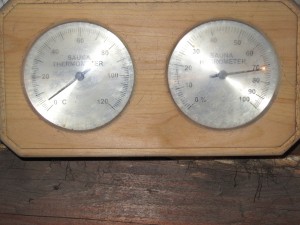
I light the stove and start watching.
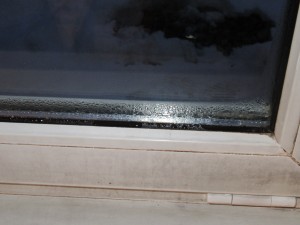
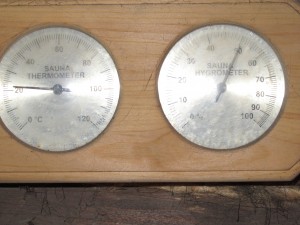
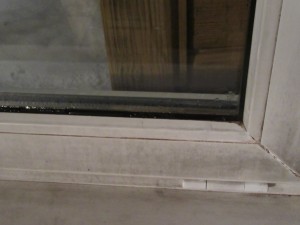
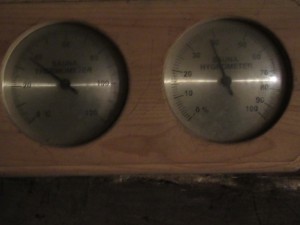
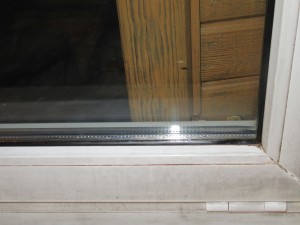
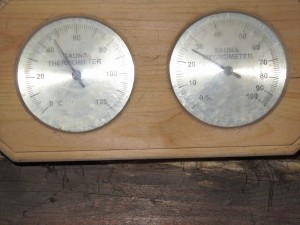
At this point, I finished fixing as unnecessary, tk. and from this I think everything is clear. When the temperature rose to 60, the humidity dropped to about 20% (I don't remember exactly now).
Previously, I argued with many that on the window, whatever one may say, but wakes up condensation, tk. large temperature difference with the street, etc. By the way, at that moment it was minus 15 on the street. So. Now there is practically no condensation on the window, although earlier this window was not just crying, but roaring)), even in the summer there was condensation. I even had to put a rag to collect the water. I did not make any changes in the design of the bath, but I changed (modified) the stove and, most importantly, installed another heating boiler, as a result of which the steam from the water, even when boiling, does not come out of it much. But before, humidity was always much higher. The minimum that was 35%. Now it comes to 15%. But thanks to this change, I am now sure that the installation location, in the plan the window will be installed in the middle of the wall or along the edge, does not matter. Or rather, taking it out to the street side, as I have everything, including in the house, it will not be worse - there will be no more condensation, and it will not decrease if installed in the center of the wall. In the boiler room, I have the same window on the facade and there is not a drop, although there is enough condensate in the house. Earlier, when there was no boiler room yet, but were heated by a stove, albeit with water heating, there was even more condensation on the home windows. Constant heating solves the problem, albeit not completely. Moreover, if it is constant, that is, it is possible either to ventilate the room more often, or to make constant ventilation, due to which the problem with condensation disappears completely. Although my wife says that when I'm not there, they don't even have to ventilate, and there is no condensation, although it can be minus 20 and below on the street. Apparently I'm breathing too hard and profusely, from which there is a lot of steam?))

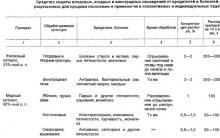









What to give a vegetarian for his birthday
Face cream at home - preparation rules
An ancient recipe for youth from Tibetan monks
How to drink clay to cleanse the body
Download maps slavic oracle